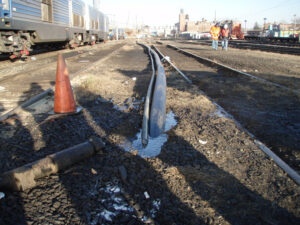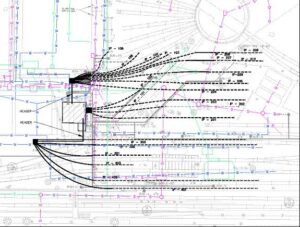Background
 The Long Island Rail Road (LIRR) Morris Park Yard, located at the Intersection of Atlantic Avenue and 121st Street in Queens, New York, is a historic rail yard with one of the few remaining operational turntables in the USA. The Morris Park Yard has been used to repair and refuel locomotives for over 100 years and continues to serve one of the nation’s busiest regional rail lines. Locomotive refueling operations over many decades resulted in significant subsurface petroleum hydrocarbon releases.
The Long Island Rail Road (LIRR) Morris Park Yard, located at the Intersection of Atlantic Avenue and 121st Street in Queens, New York, is a historic rail yard with one of the few remaining operational turntables in the USA. The Morris Park Yard has been used to repair and refuel locomotives for over 100 years and continues to serve one of the nation’s busiest regional rail lines. Locomotive refueling operations over many decades resulted in significant subsurface petroleum hydrocarbon releases.
The Challenge Presented
On behalf of LIRR, Franklin Environmental developed a remediation plan to address subsurface non-aqueous phase petroleum hydrocarbons, in compliance with regulatory requirements. LIRR selected in situ bioremediation as the remedy for the hydrocarbons located at and above the water table. Bioamendment fluid was to be introduced into the subsurface by some means that allowed infiltration into the hydrocarbon-impacted vadose zone. The area requiring remediation was covered with a dense network of railroad tracks and the hydrocarbon target depth was less than four feet below ground surface. The narrow corridors between railroad tracks did not allow installation of vertical injection wells and interconnecting piping.
Directional Technologies, Inc. (DTI) met with LIRR officials and Franklin environmental professionals to discuss the project. Neither Franklin nor LIRR had any prior experience with directional drilling technology and its capabilities. DTI was challenged with: 1) convincing an unsure client that we could safely and successfully execute the program via directional drilling methods; and 2) installing the horizontal remediation well network without disrupting the busy rail yard.
Directional Technologies at Work: Our Solution
LIRR engaged DTI to design and install 17 entry/exit horizontal remediation wells for Bioamendment injection and 10 utility conduit crossings under the busy tracks in the rail yard. Our team designed the wells to inject high-viscosity Bioamendment solution uniformly along the length of the well screens to saturate the vadose zone soils above and below the screen horizon.
DTI initially set up its drilling equipment near the location where a new remediation system equipment building was being constructed and advanced an array of well and conduit bores from that location.  As the directional drilling program progressed, our client: 1) quickly learned about the many unique capabilities of directional drilling technology, such as the ability to “steer” the drill bit in the vertical and horizontal axis and accurately measure/detect bit location 2) saw that the borings were being successfully and safely installed without interrupting rail yard operation; and 3) soon became convinced that they had made the right decision to engage DTI for this very challenging assignment.
As the directional drilling program progressed, our client: 1) quickly learned about the many unique capabilities of directional drilling technology, such as the ability to “steer” the drill bit in the vertical and horizontal axis and accurately measure/detect bit location 2) saw that the borings were being successfully and safely installed without interrupting rail yard operation; and 3) soon became convinced that they had made the right decision to engage DTI for this very challenging assignment.
The horizontal remediation well system passed beneath multiple busy railroad tracks where locomotives were fueled and serviced. The bore paths were carefully installed using subsurface steering-while-drilling techniques to avoid underground water, sewer, power, communications, and gas lines at depths very close to the bore paths. As the bore holes were advanced at Bioamendment injection targets depths, it was necessary to increase the borehole depths beneath track sections to meet LIRR geotechnical track protection standards. This procedure produced undulating bore paths that required precise directional drilling control to install the horizontal remediation wells correctly. Complex intersecting utilities at several locations exercised DTI’s proven ability to successfully combine subsurface directional drilling with surficial trenching to complete the bore paths.
DTI’s drilling schedules was closely coordinated with railroad operational schedules, allowing locomotive engine repair and refueling operations to continue uninterrupted during the six-week well installation program. DTI deployed its equipment in the narrow between-track corridors such that drilling operations were safely executed even as locomotives passed nearby.
Results that Reward
DTI safely completed this challenging assignment on schedule without interrupting the busy rail yard.